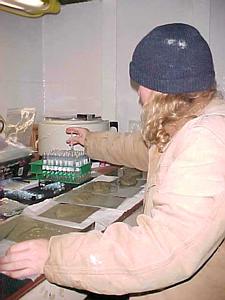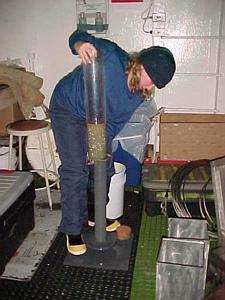17 March, 2000
We have returned to Station A and are finishing sample gathering
here. Tomorrow we will do the same at Station B. The last of the
sediment cores are being sliced and prepared for laboratory tests and
observations. To slice a sediment core, it is placed on a device
called an extruder. The extruder pushes a piston up through the
bottom of the core cylinder forcing the sediment out of the top of
the cylinder. This can be done in controlled amounts so that layers
0.5 cm and 1 cm. thick can be obtained. Some slices will be weighed
wet and then reweighed dry to test porosity (how much water the
sediment holds). Other slices are fixed with a preservative or
frozen to later be observed for larvae, nematods (roundworms), or
polychaetes (worms). Another set of samples will be treated
chemically and then frozen to later measure ATP levels.
It has been another beautiful sunny day with petrels and albatrosses
flying around the ship; even a few penguins swimming by in the water.

Sarah prepares sediment samples for ATP testing

Graduate student Sarah Mincks prepares a core tube on an extruder for slicing samples
Contact the TEA in the field at
.
If you cannot connect through your browser, copy the
TEA's e-mail address in the "To:" line of
your favorite e-mail package.
|
